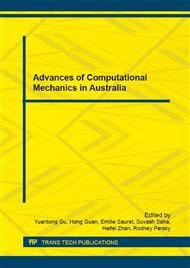p.372
p.378
p.385
p.391
p.397
p.403
p.409
p.415
p.421
Discrete Modelling of Soil-Inclusion Problems
Abstract:
A generalised approach for the modelling of arbitrary shaped deformable structures in the framework of the discrete element method is presented. Minkowski sums of polytopes and spheres are used to describe the geometry of rounded cylinders and particle facets. In the current formulation, these new elements can be deformable. Their deformation is defined by the set of positions and orientations of their nodes. The elements can be connected to form arbitrary structures, such as grids and membranes. The constitutive behaviour of such connections is defined via an elastic perfectly plastic beam model. Contacts between other not connected structures or particles are detected based on three simple primitives: spheres, cylinders and thick rounded facets. The introduction of a virtual sphere at the contact point not only allows for straightforward contact handling but as well for the use of standard contact models based on sphere–sphere interactions. Hence, there is no need for developing new contact models. The approach is implemented into the open-source framework YADE. The capability of the newly developed approach for the modelling of soil–inclusion problems is presented.
Info:
Periodical:
Pages:
397-402
Citation:
Online since:
July 2016
Authors:
Price:
Сopyright:
© 2016 Trans Tech Publications Ltd. All Rights Reserved
Share:
Citation:


